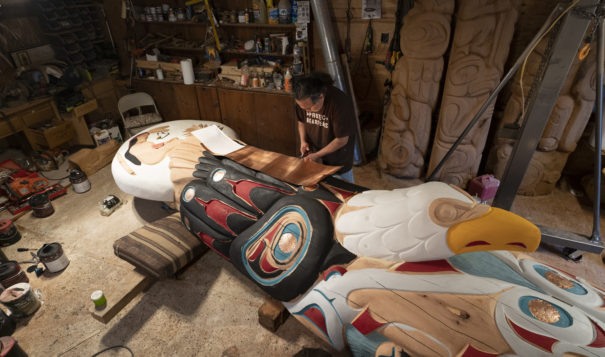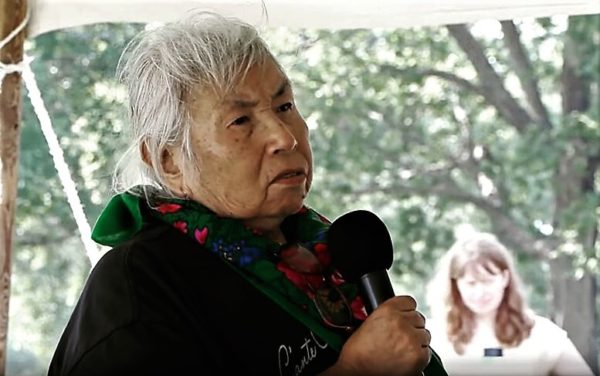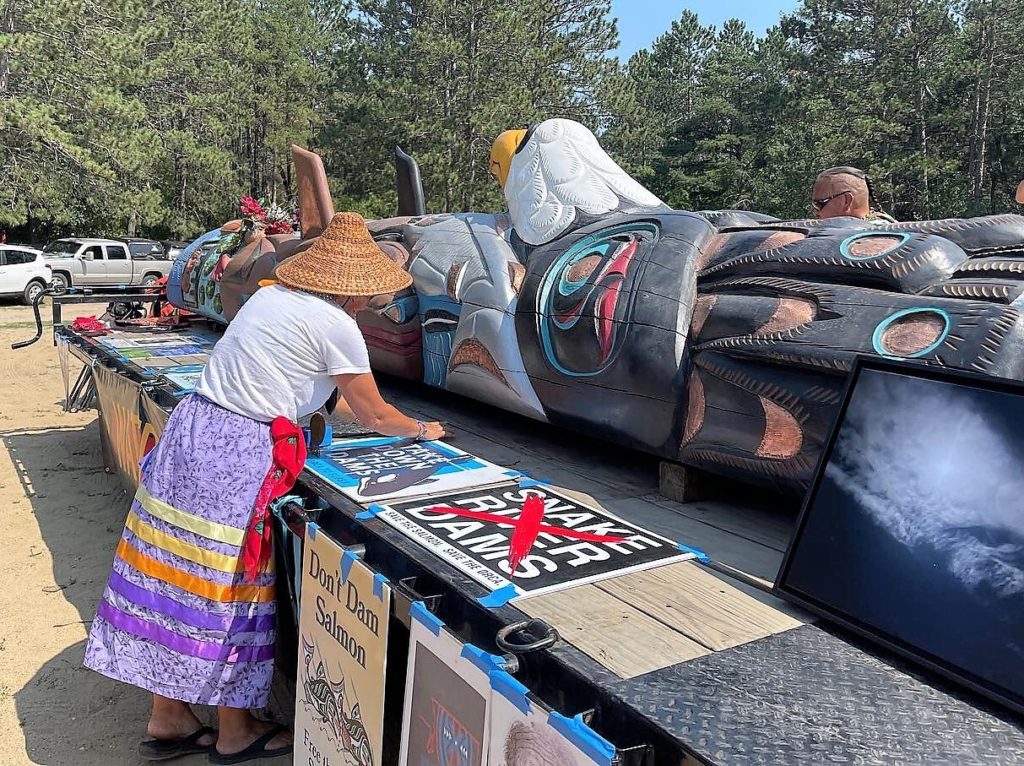News Article Article pages that do not meet specifications for other Trust Project Type of Work labels and also do not fit within the general news category.
Native rights advocates host totem pole ceremony for Missouri River
 A carver works on turning a 400-year-old red cedar tree into the totem pole carried from Washington state to Washington D.C. on the Red Road to D.C.
PHOTO BY/ Red Road to D.C.
A carver works on turning a 400-year-old red cedar tree into the totem pole carried from Washington state to Washington D.C. on the Red Road to D.C.
PHOTO BY/ Red Road to D.C.
Native grassroots water protectors led a blessing ceremony and historic gathering on the Missouri River banks July 22 to launch the Rights of the River campaign. The group aims to employ legal tools to restore Turtle Island’s longest water course and protect the basin from mounting conflicts.
Dakota, Lakota, and Nakota community representatives attending said they will push for resolutions among 28 river tribes to recognize the rights of the Mni Sosa, as it is called in the Sioux language. Advocates seek a paradigm shift that affords legal guarantees for the “spirit” of the water and for genuine stakeholder participation among heirs of its original caretakers.
As the declaration was being drafted, Ihanktonwan Treaty Committee grandmother Faith Spotted Eagle asked: “In the presence of the river, do you feel the Mni Sosa? She is listening.” Planners arranged the timing of the outdoor meeting to welcome the Lhaq’temish (Lummi) totem pole wood carvers on their journey from the West Coast to the Eastern Seaboard.
The House of Tears Carvers of the Pacific Northwest Treaty Tribes are celebrating their 20th anniversary with a Red Road to D.C. Totem Pole Journey. The July 14-30 road trip carries a commitment to honor sacred sites and Indigenous rights with prayers engraved in traditional Native arts.

The carvers are delivering the totem pole they fashioned to U.S. President Joe Biden after anointing it with blessings from hosts at numerous key locations of Indigenous treaty rights and environmental challenges. Each venue along the route to the U.S. capital is adding its unique demands to the organizers’ overarching message to Biden.
As stated in a petition accompanying the journey, Biden must “issue an executive order directing all federal agencies to require the engagement and consent of affected Native Nations, early in the planning process, and before a project is approved. The U.S. must uphold the rights of Native Nations and Indigenous Peoples to Free, Prior and Informed Consent, as set forth by the United Nations.”
The House of Tears Carvers explain that totem poles are “a medium for storytelling, for raising consciousness, for healing.” They recall that Lummi elder Tom Sampson once said, “The totem pole isn’t what is sacred. It’s the gathering of the people around the pole — that is what is sacred.”
The Rights of the River gathering at South Dakota state’s Randall Creek Recreation Area near the Ft. Randall Dam was the 110th stop on the Red Road to D.C. Totem Pole Journey. The federal hydroelectric dam obliterated White Swan Village, forcing Spotted Eagle’s family and many others into homelessness. Her Yankton Sioux Tribe is suing for the return of the area.
“The totem pole isn’t what is sacred. It’s the gathering of the people around the pole — that is what is sacred.”
Tom Sampson, lummi elder
Spotted Eagle summoned participants to lay prayers for success, while Mari Margil, executive director at the Center for Democratic and Environmental Rights, explained lawyers’ achievements in securing the rights of nature, Mother Earth, and rivers around the world.
“Conventional environmental laws treat nature as a thing,” Margil said. They legalize fracking, mining, and pipelines, “authorizing, rather than protecting us from consequences,” such as spills and erosion. This explains imbalances, such as a current species extinction rate 1,000 times higher than background, she said.
The U.S. Army Corp of Engineers has long managed the Missouri River for economic imperatives, rather than ecological or culturally relevant goals, Red Road to D.C. documentation affirms. Today, the river is weathering the threats of agrochemicals, concentrated animal feeding operations, and private hazardous infrastructure megaprojects, notably the Dakota Access Pipeline and Keystone 1 Pipeline routes through unceded Fort Laramie Treaty territory.
As a result, traditional leaders said they want to restore inherent Indigenous rights to be caretakers of the land and water of the region. The Ihanktonwan women’s Brave Heart Society is spearheading the movement for the resolutions to recognize the sovereignty and rights of the Mni Sosa. The traditional-style society, founded by Spotted Eagle, recently celebrated victory over suspension of Keystone XL Pipeline construction.

Guy Reiter, a Menominee whose nation in Wisconsin is on the verge of enacting a rights-of-nature resolution, explained the steps to put it in place on the Menominee River. The Iowa Tribe of Kansas and Nebraska is the only one on the Missouri that has such a proclamation, Spotted Eagle said.
The 2007 Water Resources Development Act authorized the Missouri River Recovery Implementation Committee. The group’s 70 federal, tribal, state, and other stakeholders from throughout the 10-state Missouri River Basin was to jointly guide its management. However, discussion in the totem pole’s presence emphasized the committee’s long-since acknowledged failure to meet Native needs.
“Human remains are constantly coming out of the river bank. The flood practices of the Corps of Engineers have brought those relatives out,” Yankton Sioux Tribal Historic Preservation Officer Kip Spotted Eagle said. “That is one of my major concerns.”
He said he is “always arguing that the entire Missouri River needs to be considered a sacred site because it’s constantly gonna be showing itself: Our people were here and there’s no way to erase that.”
The Rights of the River caucus continued to draft a declaration as the 25-ft, 5,000-pound red cedar totem pole moved on. From July 24 to 27, the carvers ushered it to Native-led mobilizations against hazardous fossil fuel pipelines – DAPL in North Dakota, Line 3 in Minnesota, and Line 5 in Michigan.
